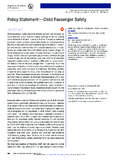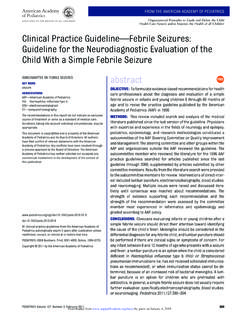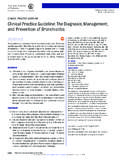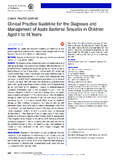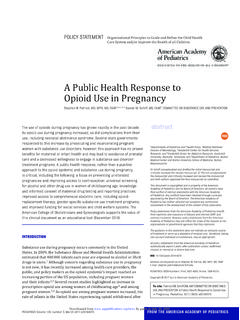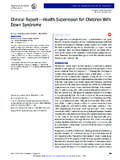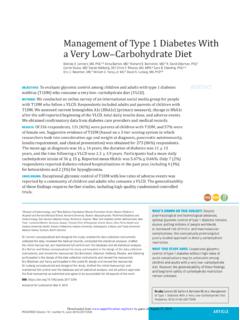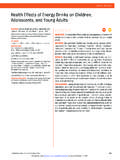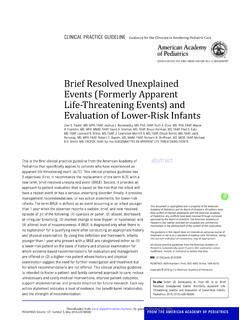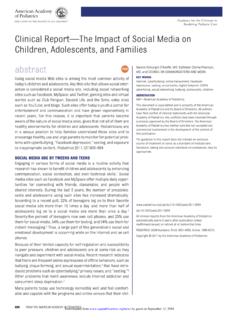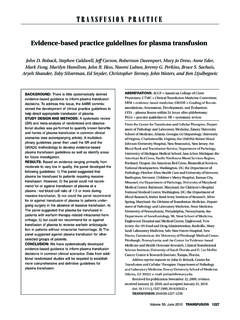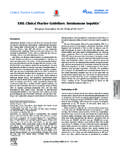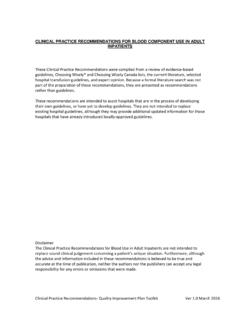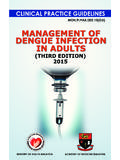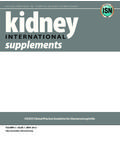Transcription of CLINICAL PRACTICE GUIDELINE Management of …
1 CLINICAL PRACTICE GUIDELINEM anagement of Newly Diagnosed Type 2 DiabetesMellitus (T2DM) in Children and AdolescentsabstractOver the past 3 decades, the prevalence of childhood obesity has increaseddramatically in North America, ushering in a variety of health problems,including type 2 diabetes mellitus (T2DM), which previously was not typicallyseen until much later in life. The rapid emergence of childhood T2DM poseschallenges to many physicians whofind themselves generally ill-equipped totreat adult diseases encountered in children. This CLINICAL PRACTICE guidelinewas developed to provide evidence-based recommendations on managing10- to 18-year-old patients in whom T2DM has been diagnosed. The AmericanAcademy of Pediatrics (AAP) convened a Subcommittee on Management ofT2DM in Children and Adolescents with the support of the American DiabetesAssociation, the Pediatric Endocrine Society, the American Academy of FamilyPhysicians, and the Academy of Nutrition and Dietetics (formerly the Amer-ican Dietetic Association).
2 These groups collaborated to develop an evidencereport that served as a major source of information for these PRACTICE guide-line recommendations. The GUIDELINE emphasizes the use of managementmodalities that have been shown to affectclinical outcomes in this pediatricpopulation. Recommendations are made for situations in which either in-sulin or metformin is the preferredfirst-line treatment of children and ado-lescents with T2DM. The recommendations suggest integrating lifestylemodifications (ie, diet and exercise) in concert with medication rather thanas an isolated initial treatment approach. guidelines for frequency of mon-itoring hemoglobin A1c (HbA1c) andfinger-stick blood glucose (BG) concen-trations are presented.
3 Decisions were made on the basis of a systematicgrading of the quality of evidence and strength of recommendation. Theclinical PRACTICE GUIDELINE underwent peer review before it was approvedby the AAP. This CLINICAL PRACTICE GUIDELINE is not intended to replace clinicaljudgment or establish a protocol for the care of all children with T2DM, andits recommendations may not provide the only appropriate approach to themanagement of children with T2DM. Providers should consult expertstrained in the care of children and adolescents with T2DM when treatmentgoals are not met or when therapy with insulin is initiated. The AAP acknowl-edges that some primary care clinicians may not be confident of their abilityto successfully treat T2DM in a child because of the child s age, coexistingconditions, and/or other concerns.
4 At any point at which a clinician feels heor she is not adequately trained or is uncertain about treatment, a referralto a pediatric medical subspecialist should be made. If a diagnosis of T2 DMis made by a pediatric medical subspecialist, the primary care clinicianshould develop a comanagement strategy with the subspecialist to ensurethat the child continues to receive appropriate care consistent with a med-ical home model in which the pediatrician partners with parents to ensurethat all health needs are ;131:364 382 Kenneth C. Copeland, MD, Janet Silverstein, MD, Kelly , MD, Greg E. Prazar, MD, Terry Raymer, MD, CDE,Richard N. Shiffman, MD, Shelley C. Springer, MD, MBA,Vidhu V. Thaker, MD, Meaghan Anderson, MS, RD, LD, CDE,Stephen J.
5 Spann, MD, MBA, and Susan K. Flinn, MAKEY WORDS diabetes, type 2 diabetes mellitus, childhood, youth, clinicalpractice guidelines , comanagement, Management , treatmentABBREVIATIONSAAP American Academy of PediatricsAAFP American Academy of Family PhysiciansBG blood glucoseFDA US Food and Drug AdministrationHbA1c hemoglobin A1cPES Pediatric Endocrine SocietyT1DM type 1 diabetes mellitusT2DM type 2 diabetes mellitusTODAY Treatment Options for type 2 Diabetes in Adolescentsand YouthThis document is copyrighted and is property of the AmericanAcademy of Pediatrics and its Board of Directors. All authorshavefiled conflict of interest statements with the AmericanAcademy of Pediatrics. Any conflicts have been resolved througha process approved by the Board of Directors.
6 The AmericanAcademy of Pediatrics has neither solicited nor accepted anycommercial involvement in the development of the content ofthis recommendations in this report do not indicate an exclusivecourse of treatment or serve as a standard of medical , taking into account individual circumstances, may CLINICAL PRACTICE guidelines from the American Academy ofPediatrics automatically expire 5 years after publication unlessreaffirmed, revised, or retired at or before that (ISSN Numbers: Print, 0031-4005; Online, 1098-4275).Copyright 2013 by the American Academy of Pediatrics364 FROM THE AMERICAN ACADEMY OF PEDIATRICSO rganizational Principles to Guide and Define the ChildHealth Care System and/or Improve the Health of all Children by guest on August 24, from Key action statements are as follows:1.
7 Clinicians must ensure that insulintherapy is initiated for childrenand adolescents with T2DM whoare ketotic or in diabetic ketoacidosisand in whom the distinction be-tween types 1 and 2 diabetes mel-litus is unclear and, in usual cases,should initiate insulin therapy forpatientsa. who have random venous orplasma BG concentrations 250mg/dL; orb. whose HbA1c is>9%.2. In all other instances, cliniciansshould initiate a lifestyle modifi-cation program, including nutri-tion and physical activity, andstart metformin asfirst-linetherapy for children and adoles-cents at the time of diagnosis The committee suggests that clini-cians monitor HbA1c concentra-tions every 3 months and intensifytreatment if treatment goals forfinger-stick BG and HbA1c concen-trations are not being met (intensi-fication is definedintheDefinitionsbox).
8 4. The committee suggests that clini-cians advise patients to monitorfinger-stick BG (see Key ActionStatement 4 in the GUIDELINE forfurther details) concentrations inpatients whoa. are taking insulin or other med-ications with a risk of hypoglyce-mia; orb. are initiating or changing theirdiabetes treatment regimen; orc. have not met treatment goals; ord. have intercurrent The committee suggests that clini-cians incorporate the Academyof Nutrition and Dietetics PediatricWeight Management Evidence-BasedNutrition PRACTICE Guidelinesin theirdietary or nutrition counseling ofpatients with T2DM at the time ofdiagnosis and as part of The committee suggests that clini-cians encourage children and ado-lescents with T2DM to engage inmoderate-to-vigorous exercise forat least 60 minutes daily and tolimit nonacademic screen time to less than 2 hours a : an individual in various stages of maturity, generally considered to be between 12 and 18 years of T2DM.
9 Disease in the child who typically is overweight or obese (BMI 85th 94th and>95th percentile for age and gender, respectively); has a strong family history of T2DM; has substantial residual insulin secretory capacity at diagnosis (reflected by normal or elevated insulin andC-peptide concentrations); has insidious onset of disease; demonstrates insulin resistance (including CLINICAL evidence of polycystic ovarian syndrome or acanthosisnigricans); lacks evidence for diabetic autoimmunity (negative for autoantibodies typically associated with T1DM). These patientsare more likely to have hypertension and dyslipidemia than are those with : any provider within his or her scope of PRACTICE ; includes medical practitioners (including physicians andphysician extenders), dietitians, psychologists, and : according to the American Diabetes Association criteria, defined as1.
10 HbA1c (test performed in an appropriately certified laboratory); or2. fasting (defined as no caloric intake for at least 8 hours) plasma glucose 126 mg/dL ( mmol/L); or3. 2-hour plasma glucose 200 mg/dL ( mmol/L) during an oral glucose tolerance test performed as described bythe World Health Organization by using a glucose load containing the equivalent of 75 g anhydrous glucose dissolvedin water; or4. a random plasma glucose 200 mg/dL ( mmol/L) with symptoms of Volume 131, Number 2, February 2013365 FROM THE AMERICAN ACADEMY OF PEDIATRICS by guest on August 24, from INTRODUCTIONOver the past 3 decades, the preva-lence of childhood obesity has in-creased dramatically in NorthAmerica,1 5ushering in a variety ofhealth problems, including type 2 di-abetes mellitus (T2DM), which pre-viously was not typically seen untilmuch later in life.
